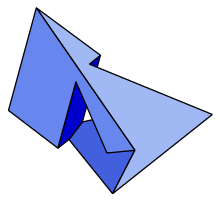Szilassi polyhedron
The Szilassi polyhedron is a non- convex polyhedron with a hole and seven hexagonal sides, with two sides sharing a common edge. It has 21 edges and 14 corners.
It has the topology of a torus ( Euler characteristic , gender ) and provides an example of a polyhedron in which the full number of seven colors (according to the Ringel-Youngs theorem ) are necessary to color the card.
Besides the tetrahedron, it is the only known polyhedron in which every side has a common edge with every other side.
The polyhedron was discovered in 1977 by the Hungarian mathematician Lajos Szilassi (* 1942). It is dual to the Császár polyhedron discovered in 1949 .
literature
- Martin Gardner , Mathematical Games: In Which a Mathematical Aesthetic is Applied to Modern Minimal Art, Scientific American, November 1978
Web links
- Tom Ace The Szilassi polyhedron
- Szilassi Polyeder at mathworld
- Paper model sewing pattern, pdf
- Interactive 3D model of a Szilassi polyhedron
Individual evidence
- ↑ Lajos Szilassi Regular toroids , Structural Topology 13, 1986, pp. 69-80



